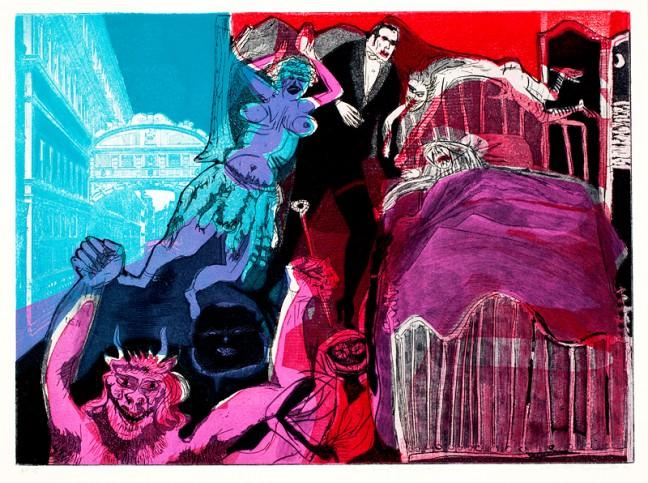It was toward the end of a 34-day armed seizure of an Alexian monastery, when Marlon Brando entered the rural town of Gresham, Wisconsin. In January 1975, the actor came to support the Menominee Warrior Society, who claimed the property belonged to them.
The standoff ended about a month later when the Alexian Brothers sold the land for $1, but the story had gained national attention and subsequently the eye of Madison artist Warrington Colescott.
Shortly after, the artist — and then-University of Wisconsin printmaking professor — created a complex print of a violent exchange that followed Marlon Brando’s arrival. The imagery of such a famous man entering the small rural town juxtaposed with the vicious imagery is simultaneously troubling and comedic.
The story always had the makings of a great Colescott satire; it was at the intersection of serious and absurd. It had deep historical implications with a tinge of humor perfectly ripe for Colescott’s comedic eye.
Now 94 years old, Colescott has accumulated an extensive catalog of such works. He is an artistic and prolific fun-poker, who has made an incredibly successful career out of laughing at everyone and everything.
But despite international acclaim and a 37-year professorship at UW, Colescott now lives in rural Wisconsin and communicates solely by phone or mail. He is a well-respected printmaker and one of Madison’s best-kept secrets.
“Warrington is a challenge to pin down,” James Dennis, a close friend and colleague at UW, said. “If you meet him and talk to him, he talks very much like his prints look. He loves to tell stories. He laughs at life and consequently he is 94.”
Nothing is safe from the ever-laughing eye of Colescott, history being a particularly popular muse. But Colescott refuses to present history as we know it best; everything has a new perspective.
“Even violence comes up as ironically attractive in Warrington’s prints, battles, warfare, Verdunn …” Dennis said. “He was a lieutenant in artillery in World War II in the South Pacific. He ended up in Korea, but he makes fun of that too.”
Colescott has shown these works in galleries in Germany but is still humbled when discussing his prints displayed in the Madison Museum of Contemporary Art. The collection, “Death in Venice: Warrington Colescott and Thomas Mann,” has emerged from MMoCA’s permanent collection and is now on display at the Henry Street Gallery until April 2016.
The “Death in Venice” collection is a group of 10 prints that illustrate Thomas Mann’s famous novella of the same name.
Although Mann’s story is significantly darker than Colescott’s previous caricatures and political satires — like the literary inspiration Mann — he is mainly interested in telling a good story.
“My art is a visual art and I like a good narrative,” Colescott said. “I enjoy illustrating a really good, interesting, complicated story and that’s what Thomas Mann does. That is the basis of his work.”
Each of Colescott’s pieces examines a passage from the book, infusing the words with bright color and imagination. The exhibition mixes death with extravagant life, irony and macabre drama.
“He’s such an amazing colorist and to see what he does with the shaped plates to create different effects,” Mary Chapin, who compiled his complete catalog, said. “It is all so interesting to see how he works with the story. It’s not necessarily a literal translation of the story but an evocative movement tracing the story of ‘Death in Venice.’”
Colescott worked on “Death in Venice” at an especially productive and successful point in his career. He was teaching at UW and still created over 250 prints with the help of his students and wife Frances Myers, who was also a professor at UW.
They worked closely together and even had simultaneous shows in Germany at Dennis’ gallery. Colescott was responsible for helping grow the UW Art Department into one of the foremost for printmaking in the country. His students went on to have their own success like acclaimed artist, Bruce Nauman, whom Colescott has worked with.
With a catalog numbering in the several hundreds that covers a breadth of subjects and techniques, Colescott already has a legacy stretching from State Street to the Guggenheim.
Myers and Colescott once shared a meal with Chapin, who was then collecting stories and information for the complete catalog of his work. While they ate a Swiss meal in New Glarus, Wisconsin, Myers explained Colescott’s artistic process and the basis for such works as “Death in Venice:”
“’Warrington makes art like he cooks,’” Chapin said. “’He never follows the recipe and he is always taking a little bit from here and a little bit of that from there, and you never know how it’s going to turn out, but it’s always wonderful.’”


